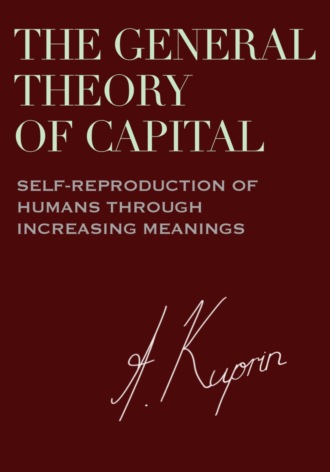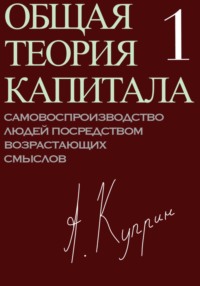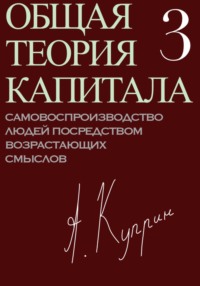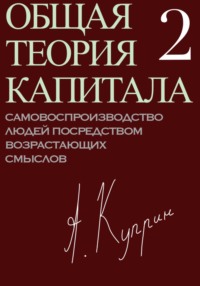
Полная версия
The General Theory of Capital: Self-Reproduction of Humans Through Increasing Meanings
“With the huge population losses caused by the Black Death in many parts of Afro-Eurasia, cities shrank, farmlands were abandoned, and economies contracted. However, as had happened so many times in the past, growth soon resumed to kick-start a new Malthusian cycle that would last well into the 18th century” (Benjamin 2016, p. 267).
Cumulative cultural evolution continued through successive rises and falls of cultures-societies. Paradoxically, social collapse is an inherent element of cultural evolution. Increasing meaning complexity is like climbing the peaks of an adaptive landscape: the higher meaning climbs, the more complex it is. But neither people nor meanings know in advance which peaks are the highest and most promising. Sometimes a collapse is necessary to come back down and begin climbing a new, possibly higher peak.
The collapse of culture-societies meant a fall in socio-cultural complexity, but for the people who formed these societies, it meant the restoration of justice and freedom, which were necessary for any further development:
“What I wish to challenge here is a rarely examined prejudice that sees population aggregation at the apex of state centers as triumphs of civilization on the one hand, and decentralization into smaller political units on the other, as a breakdown or failure of political order. We should, I believe, aim to ‘normalize’ collapse and see it rather as often inaugurating a periodic and possibly even salutary reformulation of political order” (Scott 2017, p. 210). “There may well be, then, a great deal to be said on behalf of classical dark ages in terms of human well-being. Much of the dispersion that characterizes them is likely to be a flight from war, taxes, epidemics, crop failures, and conscription. As such, it may stanch the worst losses that arise from concentrated sedentism under state rule. The decentralization that arises may not only lessen the state-imposed burdens but may even usher in a modest degree of egalitarianism. Finally, providing that we not necessarily equate the creation of culture exclusively with apical state centers, decentralization and dispersal may prompt both a reformulation and a diversity of cultural production” (ibid., p. 217).
Collapses and dark ages also create conditions for meaning drift. Meaning drift is a random change in the frequency of a meaning due to the small population among which this meaning is common. Meaning drift results in a small number of meanings being distributed among a disproportionately large number of people. After their dark ages, the Greeks did not return to Linear B script but adopted the Phoenician alphabet (Scott 2017, pp. 147-148).
Collapses break down the dead ends of cultural evolution and open up paths to meanings that allow for more efficient adaptation. The division of activity, order and active power enables the creation of new counterfacts. The traditional choice between counterfacts, in turn, increases the variety of men and meanings, albeit slowly:
“It is, then, not simply more men, but more different men, which brings an increase in productivity. Men have become powerful because they have become so different: new possibilities of specialization depending not so much on any increase in individual intelligence but on growing differentiation of individuals—provide the basis for a more successful use of the earth’s resources” (Hayek 1988-2022, vol. 1, pp. 122-123).
The evolution of meanings accelerated due to the accumulation of cultural experience and the expansion of the set of counterfacts on the basis of which the traditional choice was made. Traditional society and order became more complex. As socio-cultural development progressed, the multiplicity and mass of activities required for the reproduction of culture-society gradually exceeded the multiplicity and mass of activities required for the reproduction of individuals. In other words, the complexity of the culture-society increasingly surpassed the complexity of its individuals. Since the mass of added activity exceeded the mass of necessary activity, a difference arose between them—surplus activity and surplus product.
“If the laborer wants all his time to produce the necessary means of subsistence for himself and his race, he has no time left in which to work gratis for others. Without a certain degree of productiveness in his labor, he has no such superfluous time at his disposal; without such superfluous time, no surplus labor and therefore no capitalists, no slave-owners, no feudal lords, in one word, no class of large proprietors” (Marx and Engels 1975-2004, vol. 35, p. 512).
The entire product is made in production, but its division into necessary and surplus products occurs in circulation, in the relations of gift-giving, redistribution and commodity exchange. This means that the growth of surplus activity and surplus product is linked not only to the division of activity and active power, but also to the division of order: chiefdoms and states based on voluntary and forced tributes evolved as they “learned” to increase and extract the surplus product:
“The imperative of collecting people, settling them close to the core of power, holding them there, and having them produce a surplus in excess of their own needs animates much of early statecraft. … The means by which a population is assembled and then made to produce a surplus is less important in this context than the fact that it does produce a surplus available to nonproducing elites. Such a surplus does not exist until the embryonic state creates it. Better put, until the state extracts and appropriates this surplus, any dormant additional productivity that might exist is ‘consumed’ in leisure and cultural elaboration. Before the creation of more centralized political structures like the state, what Marshall Sahlins has described as the domestic mode of production prevailed” (Scott 2017, pp. 171-172).
The ratio between surplus and necessary activity (and their products) forms the rate of surplus activity. The more the complexity of the culture-society exceeds the complexity of the individuals, the higher the rate of surplus activity.
Since, as we have seen above, Marx did not yet know and could not know that complex labor cannot in principle be reduced to simple labor, he could not have known either that added activity cannot be reduced to necessary activity. If for Marx surplus labor and surplus product were produced by the workers and other exploited classes, and appropriated by the exploiting classes, then from our point of view the surplus activity and its products are produced by culture-society as a whole, and the manner of their appropriation depends on the relative political, economic and cultural* power (or authority) of the state, social categories and individuals.
As long as the surplus product was redistributed for the benefit of officials and the army, states were satisfied with a vertical, i.e. centralized, calculation and accounting. The growth of crafts and cities led to a horizontal, i.e. decentralized, circulation of the surplus product. Surplus activity and the need to put its product into circulation were the driving force behind the long process of value and money development. Money spread where the surplus product was extracted from the immediate producers and transferred to an indefinite number of people through the mechanisms of competitive circulation.
Possession, investment and profit
The multiplication of meanings implies a specialization of subjects (artisans, officials, priests, etc.) and an increase in the complexity of their active power—experience and personality. New types of norms arise that regulate communication; human relationships are increasingly mediated by meanings and turn into relations of social roles. When the subjective side of activity is mediated and becomes an abstraction, the objective side also becomes an abstraction: things as means of activity become rights and duties. With the further division of the socio-cultural order, possession develops as a right of disposal, which is associated with the obligation to use. Possession complements and replaces application. If application is the disposal of a thing in the process of use, then possession is the disposal of the user, not tied to the process of use. This applies to both private and community possession.
The quantity of cultural bits contained in the subject and in the means of activity constitutes their meaning mass. The composition of meaning is the ratio between the mass of meanings contained in the subject (actor) and the mass of meanings contained in the means of activity. The mass of meanings in the activity itself depends on this ratio. The lower the meaning composition, the more complex the subject in relation to the means of activity, the smaller the mass of meanings in the means of activity relative to the mass of meanings in the subject—for example, if a skilled worker uses simple tools. And vica versa, the more complex the means of activity in relation to the subject, the greater the mass of cultural bits in things in relation to that in people, the higher the composition of meaning.
Forms of organization such as application and possession are characteristic of activities with a low composition of meaning, when an individual or a family is able to independently create or acquire the means necessary for the activity. The means here remain small, dwarfish by nature:
“Before capitalistic production, i.e., in the Middle Ages, the system of petty industry obtained generally, based upon the private property of the laborers in their means of production; in the country, the agriculture of the small peasant, freeman or serf; in the towns, the handicrafts organized in guilds. The instruments of labor—land, agricultural implements, the workshop, the tool—were the instruments of labor of single individuals, adapted for the use of one worker, and, therefore, of necessity, small, dwarfish, circumscribed. But, for this very reason they belonged, as a rule, to the producer himself” (Marx and Engels 1975-2004, vol. 24, pp. 307-308).
However, possession presupposes more complex tools than application. The transformation of application into possession is associated with the complication of activity and its product and an increase in the rate of surplus activity. Application is widespread as long as the surplus product is insignificant and the means are no more than simple tools. As meanings increase, private appropriation of the surplus product develops. The more surplus product an individual or family can obtain, the more interested they are in organizing private production and securing their rights:
“But the vital thing is parcel labor as a source of private appropriation. It gives way to the accumulation of personal chattels, for example cattle, money and sometimes even slaves or serfs. This movable property, beyond the control of the commune, subject to individual exchanges in which guile and accident have their chance, will weigh more and more heavily on the entire rural economy. There we have the destroyer of primitive economic and social equality” (Marx and Engels 1975-2004, vol. 24, p. 367).
As the surplus product grows, meanings accumulate and the composition of meaning becomes higher, possession replaces application. However, possession is still based on the labor of the immediate producer himself. Marx and Engels called possession “property based on one’s own labor”:
“Political economy confuses on principle two very different kinds of private property, of which one rests on the producers’ own labor, the other on the employment of the labor of others. It forgets that the latter not only is the direct antithesis of the former, but absolutely grows on its tomb only” (Marx and Engels 1975-2004, vol. 35, pp. 751-752).
The growth of surplus product leads to the transformation of production for consumption and giving into commodity production based on money relations. Use value and exchange value as socially necessary multiplicity and mass of existence values find their way through the immense variety of individual opinions about required activities and products. The further production for exchange advances, the more money relations spread, the more added activity becomes added value, necessary activity becomes the value of active power and surplus activity becomes profit.
The surplus activity and its product represent the difference between the quantity of production and the quantity of consumption. Thus, the surplus product is the source of all accumulation. The higher the value of the surplus product, the greater the possibilities for saving and investing, i.e. making means of production. The rate of surplus activity determines the potential for accumulation of meanings. However, saving does not necessarily mean investing. The amount of investment is defined by expectations regarding the surplus activity and its product, i.e. profit.
The relationship between investment and surplus activity/product constitutes the essence of profit. Although profit arises in traditional society, here it is not yet the basis for the organization of self-reproduction and is thus completely random in nature. At this early stage, it is obvious that the source of profit is uncertainty. The primitive division of meanings and the low rate of surplus activity characteristic of subsistence economy limit the possibilities of making profit. Here, production is viewed as a means of consumption rather than as a means of exchange and profit:
“Aristotle insists on production for use as against production for gain as the essence of householding proper; yet accessory production for the market need not, he argues, destroy the self-sufficiency of the household as long as the cash crop would also otherwise be raised on the farm for sustenance, as cattle or grain; the sale of the surpluses need not destroy the basis of householding. … In denouncing the principle of production for gain as boundless and limitless, ‘as not natural to man;’ Aristotle was, in effect, aiming at the crucial point, namely, the divorce of the economic motive from all concrete social relationships which would by their very nature set a limit to that motive” (Polanyi 2001, pp. 56-57).
Possession emerges at a very low rate of surplus activity. At this stage, small possessors cannot yet achieve a sufficient rate of surplus activity to set in motion a cycle of expanded self-reproduction; the appropriation of surplus activity/product remains the prerogative of the state and the nobility, who collect the surplus and spend it on status consumption (palaces and temples) or large-scale structures and administration (irrigation systems, standing army, tax apparatus, etc.):
“At the time of the Spanish conquest the Texcoco, Chaco, and Xochimilco lakes had about 12,000 ha of chinampa fields. Their construction required at least 70 million man-days of labor. The average peasant had to spend no less than 200 days a year to grow enough food for his own family, so he could not work more than about 100 days on large hydraulic projects. As a good portion of this time had to be devoted to the maintenance of existing embankments and canals, seasonal labor of at least 60 and up to 120 peasants was needed to add 1 ha of a new chinampa. The means were different—but the pre-Hispanic basin of Mexico was clearly as much a hydraulic civilization as Ming China, its great Asian contemporary. Long-term, well-planned, centrally coordinated effort and an enormous expenditure of human labor were the key ingredients of its agricultural success” (Smil 2017, p. 99).
The complication of activity implies an increase in mediation, i.e. a growing mass of meanings materialized in the means of activity. A growing meaning mass per unit of product affects both the production of consumer articles and the making of means of production (investment). The prerequisite for increasing mediation is accumulation—saving surpluses and investing them in means of production. Accumulation implies that both the means of production and their making become more complex and the composition of meaning is higher. More complex means of production require broader cooperation and more sophisticated administration.
“Undoubtedly the most important, and lasting, contribution to intensified cropping in China was the design, construction, and maintenance of extensive irrigation systems. The antiquity of these schemes is best shown by the fact that nearly half of all projects operating by the year 1900 had been completed before the year 1500. The origins of perhaps the most famous one, Sichuan’s Dujiangyan, which still waters fields growing food for several tens of million people, go back to the third century BCE. … The construction and unceasing maintenance of such irrigation projects (as well as the building and dredging of lengthy ship canals) required long-range planning, the massive mobilization of labor, and major capital investment. None of these requirements could be met without an effective central authority. There was clearly a synergistic relationship between China’s impressive large-scale water projects and the rise, perfection, and perpetuation of the country’s hierarchical bureaucracies” (Smil 2020, pp. 93-94).
Investment is, by its definition, not production for consumption, since it is aimed at producing means of production and not consumer articles. The larger the investment, the less it is production for consumption and more it is production for exchange. Robert Lopez showed that although water mills were already used in antiquity, their relatively high cost meant that they did not spread in Europe until the Middle Ages, when slave labor was transformed into peasant labor. Greater freedom was a condition for greater efficiency. The deficit of slave labor forced the search for mechanical methods of grinding grain, while at the same time the lord of the manor forced the peasants to grind their grain in his mill. The shortage of rivers and streams to support waterwheels, in turn, led to the spread of windmills, which were not used in antiquity (Lopez 1976, pp. 43-44). An increase in meaning is an increase in mediation, the latter requires more freedom for the subjects, and more freedom requires a more complex socio-cultural order.
Property, debt and interest
Property arose as the disposal of the non-user in parallel with and in place of possession as the disposal of the immediate user. If the origin of possession is to be sought in the possessor’s own labor, then the origin of property is to be sought in political and economic norms. Property arises as political property when one group of people is able to subjugate another group, when one part of the population rises as a political force over another part. Property makes it possible to create elaborate means of production, to invest on a large scale, to maintain a sufficient duration of the production and circulation, to calculate and distribute risks. If possession is a feature of a low composition of meaning, then political property is a feature of an activity with a high composition. Political property is associated with the rise of chiefdoms and states. Irrigation systems, military installations, massive ancient and medieval architecture are its material evidence.
“Thus, in tribal hydraulic societies property is simple, but it is simple with a specific tendency toward the predominance of political, power-based, property. This tendency increases with the size of the community. It becomes decisive in simple hydraulic commonwealths that are no longer directed by a primitive (tribal) government, but by a state” (Wittfogel 1957, p. 238).
Changes in the rate of surplus activity, in value saving and investment, draw a line between application, possession and property. The value of a surplus product is a “quantitative expression” of disposal and use: the transition from application to possession and from the latter to property is associated, first, with an increase in the size and rate of the surplus product, and, second, with a shift in the mechanisms of alienation and appropriation of the surplus product—from brute physical force to customs and from there to laws. Political ownership enables the appropriation of the surplus activity or its product in direct natural form—for example, in the form of corvée labor or rent in kind.
Simple self-reproduction is characterized by unstable accumulation. Periods in which increased surplus allows the large-scale making of means of production—irrigation systems, for example —are often followed by periods in which what has been achieved is consumed and destroyed. The very structure of the traditional order, with its political ownership, its communal and private possession, implies that investment is either reduced to the activity of the all-powerful king (or chief), who is unable to implement the many projects necessary for the division of meanings, or that investment is reduced to the petty activities of individuals and families who cannot raise enough funds for significant projects.
Appropriation in kind contains a contradiction in itself: on the one hand, it is a condition for the existence of the polity; but on the other hand, by appropriating labor or its product in kind, the polity hinders the development of a competitive commodity exchange. Overcoming this contradiction required the transformation of political or state property into economic or private property, the development of written laws, fiat money and interest.
Gunnar Heinsohn and Otto Steiger showed that debt and interest arise when possession turns into private property. In their view, possession is a physical or material concept, while property is an immaterial or legal concept:
“Possession always means the right to dispose of certain goods or resources and thus to use them physically, and is independent of whether property rights exist or not” (Heinsohn und Steiger 2009, p. 91). “Property never arises naturally. It can only be created by a legal, i.e., non-material action. Once property is created, it carries an unearned and intangible premium, the property premium. This premium exists in addition to the physical use of the goods or resources held and consists of two forces: (i) it is capable of supporting the issue of money, which can only be created in a loan agreement, and (ii) the right to this premium serves as collateral to obtain a loan” (ibid., p. 471).
Since its very inception, money has served the purpose of accumulation, i.e. saving and investing value. For a long time, this function was limited to precious metals as a tangible form of money. Fiat money emerged with the advent of credit. Medieval states needed money for their projects, especially to wage war and pay mercenary armies. They obtained money by borrowing it from creditors. However, political property is the prerogative of the state, and the sovereign often considered what he had borrowed as his property, i.e. he did not repay the debt. Creditors, suffering from the arbitrariness of the state, developed a new form of property—economic or private:
“Montesquieu describes here first how commerce was hampered by the prohibition of interest-taking by the church and was consequently taken up by the Jews; how the Jews suffered violence and constant extortions at the hands of nobles and kings; and how eventually they reacted by inventing the bill of exchange (lettre de change). The final portion of the chapter draws striking conclusions: ‘…and through this means commerce could elude violence, and maintain itself everywhere; for the richest trader had only invisible wealth which could be sent everywhere without leaving any trace. … In this manner we owe … to the avarice of rulers the establishment of a contrivance which somehow lifts commerce right out of their grip’” (Hirschman 1977, p. 72).
The transition from political to private property, i.e. the emergence of bills of exchange and the development of sovereign debt, led to monetary transactions as a special type of commodity transactions in which it is not goods that are traded, but money itself. The payment for money is interest.
“… Money as a whole takes on a very distinctive character in specific monetary transactions; that is, when it does not function as a medium of exchange to other objects, but as the central content, as the object of a transaction sufficient to itself. Money is an end in itself in the purely bilateral financial operation not only in the sense that it has suspended its qualities as a means, but also in the sense that it is, from the outset, the self-sufficient center of interest, which also develops its own distinctive norms and, at the same time, completely autonomous qualities and a corresponding technique” (Simmel 2004, p. 309).






